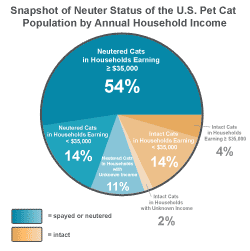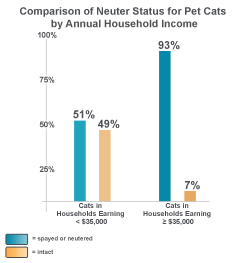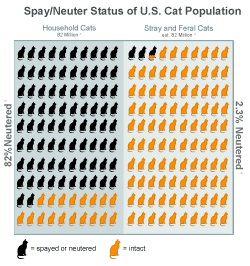Eighty percent of cats in U.S. households are neutered, according to a new, nationally representative study conducted by Alley Cat Allies and published in the Journal of the American Veterinary Association, a leading peer-reviewed scientific journal.
The  study, “Population characteristics and neuter status of cats living in households in the United States,” found that family income was the single strongest predictor of whether pet cats living in households are neutered. Over 90% of cats in households earning $35,000 or more per year were neutered, compared to 51% of cats in households earning less than $35,000.
study, “Population characteristics and neuter status of cats living in households in the United States,” found that family income was the single strongest predictor of whether pet cats living in households are neutered. Over 90% of cats in households earning $35,000 or more per year were neutered, compared to 51% of cats in households earning less than $35,000.
 These neuter rates are a cause for optimism: they indicate that neutering is an accepted, established practice among the large majority of Americans with pet cats. As a result, our nation’s pet cats are living healthier lives. Despite the disparity based on household income, it bears reemphasizing that the majority of pet cats living in households across all income levels are neutered.
These neuter rates are a cause for optimism: they indicate that neutering is an accepted, established practice among the large majority of Americans with pet cats. As a result, our nation’s pet cats are living healthier lives. Despite the disparity based on household income, it bears reemphasizing that the majority of pet cats living in households across all income levels are neutered.
The study was based on data collected by Harris Interactive for Alley Cat Allies and then analyzed by Alley Cat Allies using a rigorous statistical approach, and is the first nationally representative study to document that household income is positively associated with a cat’s neuter status.
Increasing Neuter Rates for Cats: Next Stop Stray and Feral Cats
When looking at the neuter rates of cats in U.S. households, it is important to remember that pet cats represent only a part of the entire U.S. cat population. Scientists estimate that there may be as many stray and feral cats in the United States as there are cats living in people’s homes. In contrast to the high neuter rate of pet cats, the most comprehensive research to date indicates that less than 3% of stray and feral cats are neutered.
The lives of all catspet, stray, and feralare improved through neutering. This important new study underscores the need to recognize that most intact cats are stray and feral cats. And among lower income cat owners who responded to the study, cost was the most common reason cited for not neutering their pets. Expanding the accessibility and affordability of low-cost, high-volume spay and neuter programs is a critical step to increasing the neuter rate among both pet cats in lower income households as well as stray and feral cats.
“[A]ny attempts to increase the proportion of neutered cats in the United States must include stray and feral cats.”
Journal of the American Veterinary Medical Association, 2009; 234: 1023-1030, Chu K, Anderson WM, Rieser MY. Population Characteristics and Neuter Status of Cats Living in Households in the United States. Read More »


